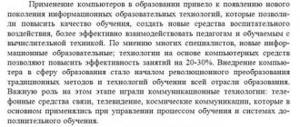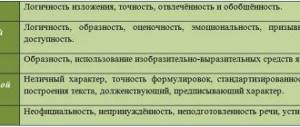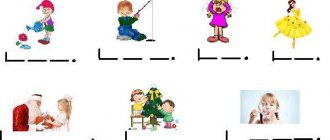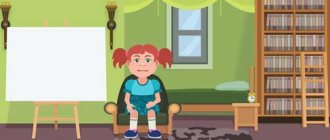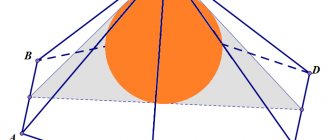Lesson on preparing for a condensed presentation in 9th grade
Russian language lesson in 9th grade on the topic: “Preparation for a concise presentation of the text.” Teacher: Budnikova Tatyana AlekseevnaLesson objectives:
- Educational:
- learn
to formulate the main theme and idea of the text; - identify micro-topics yourself;
- use different methods of text compression.
Educational:
- Enrich your speech with lexical, morphological, syntactic, stylistic means of language.
- develop memory, thinking
Educational:
Pay attention to the moral categories of the text
Equipment
: didactic material (text of presentation - 1 copy for each student), reminders “How to write a concise presentation”, “How to check what you have written”.
During the classes.
1. Repetition of the concept of condensed presentation. Teacher. In class we will prepare to write an essay. Concise presentation. Remember what is special about this type of presentation? Student. In a concise presentation, we will retell individual fragments of the text briefly, leaving only the most important and essential. Teacher. Indeed, the task of a detailed presentation is to reproduce the source text as completely as possible while preserving the author’s style. A concise presentation requires skills in selecting essential information, briefly conveying the content of the text, provided that the author’s main thoughts, the sequence of events, and the characters of the characters are conveyed without distortion.
2. Setting lesson goals. Repetition of the lexical meaning of terms that will appear throughout the lesson.
Teacher. The goal of our lesson is for each of you to learn to perceive and correctly interpret the content of the source text, identify micro-themes and reproduce the content of each micro-theme of the source text in your own written work. Teacher. What is a myctotema? Student. A microtheme is the theme of a fragment of text, part of it. The sum of microthemes conveys the main content of the text.
3. Familiarity with the text. Teacher. You listen to the text, perceive the text as a whole, highlight the main and secondary in the content, assimilate the storyline and ultimately get an emotional mood, which will help you write a concise summary.
Rudeness in language, like rudeness in manners, sloppiness in clothing is a very common phenomenon, and it testifies to a person’s insecurity, his weakness, and not at all about strength. I'm not even talking about the fact that this is a sign of bad manners and sometimes cruelty.
A truly strong and balanced person will not speak loudly and swear unnecessarily. After all, it has long been known that our every action, our every word is reflected on those around us and is hostile to the most precious thing in the world - human life. And a strong person, understanding all this, is precisely strong because of his nobility and generosity.
You need to learn good, calm, intelligent speech for a long time and carefully - listening, memorizing, reading. But even though it’s difficult, it’s necessary, really necessary! Our speech is the most important part not only of our behavior, but also of our personality, our soul, mind, our ability not to succumb to the influences of the environment if it is “dragging”.
(According to D.S. Likhachev) 136 words
Teacher. For this text, you must write a concise summary, and for this we will work on the content of the text.
4. Text analysis.
Teacher: Name the features of the text. Student: 1. The sentences are united by one topic. Words of the same topic were used. 2. The text has an idea. Student. The topic of the text is the role of language in the life of society
The idea of the text is that you need to learn correct intelligent speech. 3.The text can be titled. The role of language in society
Student: 4. The text is divided into three paragraphs.
- For what purpose was this done? Each paragraph contains a micro-topic that reflects the main topic. — Let’s determine the micro-topic of each paragraph and write it down in plan form. Teacher: Make a plan for the text. Student: Outline of the text. 1.Rudeness in language is a sign of bad manners.
2. The word is reflected in human life.
3. You need to learn good speech.
. Teacher. Determine the type of this text. Prove it. Student. The type of this text is reasoning, because the author of the text talks about the role of language in the life of society. In this text we clearly see: thesis - Rudeness in language is a sign of bad manners. Further in the text there is evidence: 1. Rudeness indicates a person’s weakness. 2. The word is reflected in human life. 3. Good speech needs to be learned.
Teacher. It is very important to correctly determine the type, since the functional and semantic types of speech are constructed in different ways, the reasoning is structured as follows: 1) the main position (thesis); 2) evidence using arguments; 3) conclusion. When writing a presentation, you must ensure that the content of the source text is conveyed without distortion, important episodes are preserved, and disparate facts are not generalized. Determine the style of this text. Student. The style of the text is journalistic. It influences the reader and introduces certain information. Addresses current issues of our time that are of interest to society. The author of the text encourages people to learn correct intelligent speech. Teacher. Pay attention to the vocabulary of journalistic style. The words are cumbersome and heavy.
5. Work on text compression.
Group work
Children work for 3-5 minutes.
Introduction to microtheme keywords (Slide 10)
— Next, each group determines the main information in its microtopic. (slide)
Teacher. We must write a concise summary of this text. Teacher. In what ways can we compress text? Student. The first method is called an exception. When excluding, from the point of view of the main idea of the text, we omit details and unnecessary details. Student. The second way is generalization. When generalizing, individual facts are first isolated and then combined using special linguistic means. Student. You can replace a group of homogeneous members with one word or phrase. Teacher. We will compress the text using the elimination method. Remember what techniques we can use for this? Student. The main language techniques for compressing text include the following. 1. Replacements: • replacement of homogeneous members with a general name; • replacing a sentence fragment with a synonymous expression; • replacing a sentence or part of it with a demonstrative pronoun; • replacing a sentence or part of it with a defining or negative pronoun with a general meaning; • replacing a complex sentence with a simple sentence; • replacing direct speech with indirect speech.
2. Exceptions: • exclusion of individual members of the sentence, some homogeneous members; • exclusion of repetitions; • exclusion of a sentence fragment that has less significant meaning; • exclusion of proposals containing descriptions or reasoning, presented too broadly and completely. 3. Mergers: • formation of a complex sentence by merging two simple ones, telling about the same subject of speech. Teacher. Read the leaflet and try to take its advice. Memo “How to write a concise presentation” 1. Highlight important (essential, necessary) thoughts (micro-topics) in the text. 2. Find the main idea among them. 3. Break the text into parts, grouping it around significant ideas. 4. Make an outline with a title for each micro-topic. 5. Think about what can be excluded in each part, what details to refuse. 6. What facts (examples, cases) can be combined and generalized in adjacent parts of the text? 7. Consider means of communication between parts. 8. Translate the selected information into “your” language. Teacher. Let's reread the text paragraph by paragraph, think about what can be excluded in each part, what details to refuse. Student.
Teacher. What text compression techniques did you use? Student. 1.replacement of homogeneous members with a general name; 2. replacing a sentence fragment with a synonymous expression 3. excluding a sentence fragment that has a less significant meaning; 4. exclusion of sentences containing descriptions or reasoning, presented too broadly and completely.
Teacher. What text compression techniques did you use? Student. 1. the formation of a complex sentence by merging two simple ones, telling about the same subject of speech. 2. exclusion of repetitions; 3. exclusion of a sentence fragment that has a less significant meaning;
1. Bringing together relatively distant thoughts in one sentence. 2. Lack of consistency in thoughts; incoherence and violation of sentence order. 3. The use of sentences of different types in structure, leading to difficulty understanding the meaning and incoherence. 4. Unsuccessful ending (duplication of output).
Independent work.
7. Summing up. Teacher. Check what you have written using the notes and assessment criteria.
REMINDER How to check what you have written 1. After writing the text as a draft, read it at least 3 times. 2. Read for the first time to check the content. Answer the questions: • Is the main content of the source text conveyed? • Is there a repetition of thoughts or omission of important information? • Can the written text be called a summary of the original text? • Are all the micro-topics of the source text reflected in the presentation? 3.Read it a second time to correct the text. Answer the questions: *Can the text be called coherent? *Are the paragraphs highlighted correctly? *Are there any grammatical errors? *Are there any speech errors? *Is your speech expressive? 4. Read for the third time to check spelling and punctuation. Use a dictionary! 5.After rewriting the text into a clean copy, also check the clean version.
List of sources used
1. Russian language: Express tutor for preparing for the State Examination: “Concise presentation: 9th grade” / E.V. Korchagina, E.S. Simakova.-M.:AST:Astrel: Polygraph Publishing House, 2010 2. New form of final certification in 9th grade: recommendations and experience.-Kazan: RIC “School”, 2009 3. Russian language. 9th grade. Preparation for the State Examination -2011: educational and methodological manual/ed. ON THE. Senina.-Rostov n/d: Legion – M., 2010
